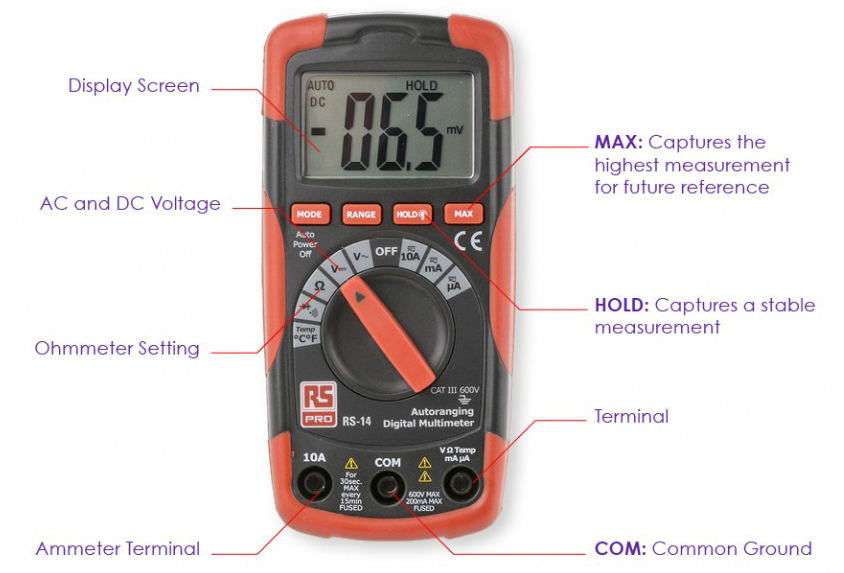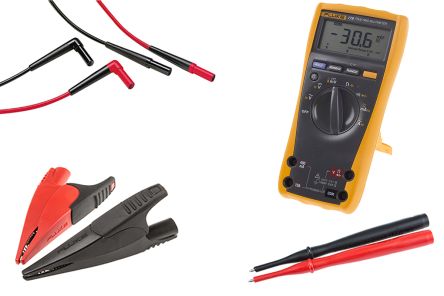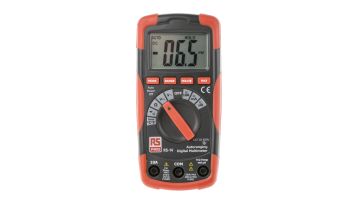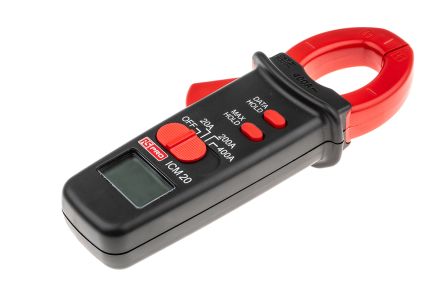A Complete Guide to Digital Multimeters
Not sure how to use a digital multimeter? Our guide also shows you how to read a multimeter & shares key products.

What is a Digital Multimeter?
Digital multimeters - often shortened to DMMs - collectively form a range of versatile and incredibly helpful tools, designed for measuring and displaying various important parameters relating to electrical and electronic circuitry.
This will typically include voltage (V), current (A), and resistance (in ohms). In short, a DMM combines the functions of a voltmeter, an ammeter, and an ohmmeter into a single handy unit.
-
Voltage is the difference in electrical potential between two points, expressed as the potential energy of an electric field to cause current flow through a conductor or circuit
-
Current is the active rate of electrical charge flow through a component or circuit, measured as it passes a designated point or region on the circuit (for most circuit types, this charge flow is typically carried by electrons moving through a wire)
-
Resistance is a measurement of the extent to which the properties of a specific device or material limit the rate of electrical current flowing through it
These devices are also known as digital multitesters, which in this context is essentially the same thing. All of these tools generally require a variety of probes and test leads to be plugged into them, to transfer signals to and from the components, contacts, wires or traces being tested.
Digital Multimeter Uses and Functions
Multimeters can be used for a wide range of monitoring, detection, analysis and troubleshooting applications, depending on what aspect and stage of electronic prototyping or debugging you are concerned with, and the specific details of the circuit, component or fault being tested.
Thus, in answer to the question ‘what is a digital multimeter used for?’, the simplest response would be any job requiring accurate readouts of device voltages and resistances as an easily measurable output value. Specific everyday examples might include:
-
Electrical testing of plug sockets and lighting setups
-
During home renovations and wiring installation
-
General analysis, measurement, debugging and troubleshooting of electronic circuits, devices and components, such as batteries, household wiring, electric motors, and power supplies
How to Use a Digital Multimeter Safely
There are numerous different methods for using a DMM to give a meaningful readout on a given type of circuit or component. Precisely how to use a multimeter properly in any specific scenario will depend largely on what you are measuring.
Common tasks you might need to carry out include:
-
Measuring device or circuit voltage
-
Measuring a component’s resistance
-
Measuring the current flowing through a circuit
-
Measuring continuity - i.e. the presence of a complete and unobstructed path for current flow - on various types of components such as switches, connections and fuses
-
Testing diodes
Each of these functions will involve using slightly different methodologies, functions and settings on your digital multimeter.
You can use the image below as a generalised digital multimeter user guide to familiarise yourself with the tool’s basic settings, components and functions:

How to Read a Digital Multimeter
In terms of knowing how to read digital multimeters properly, note that you will need to be somewhat familiar with the basic symbols found on standard electronic schematics to fully understand all of the various output readings from your DMM.
Digital Multimeter How to Guide
Digital multimeters (DMMs) are handheld tools which can measure capacitance, voltage, electrical current and resistance with diode and continuity check.
Watch our handy how to video to find out more!
Explore RS PRO Digital Multimeters
Take a look at this handy video for an in-depth look at one of our RS PRO digital multimeters. With a wide range of features, multiple functions, and powerful testing capabilities, the benefits of choosing an RS PRO digital multimeter are clear to see.
Watch the video to learn more, or click below to browse our full range of RS PRO digital multimeters.
Different Types of Digital Multimeters
Digital multimeters are extremely useful tools, used daily across a broad spectrum of both professional and hobbyist scenarios, and are widely available in various models and form factors.
A majority of the DMM models available today also provide a range of enhanced features and modes to cover an even broader array of electronics tasks and to offer full compatibility with a greater number of electrical devices and components. Importantly, the ability to switch between AC and DC current measuring capabilities is largely standard these days. AC current flows from almost all household sockets, and to some larger appliances, while most common and smaller household device types - as well as batteries, electric vehicles and mobile phones - tend to run on DC current.
Various types might also offer additional settings for continuity and diode test functions, often indicating the status of certain readings via an audible alarm. Depending on the exact model, further optional modes and advanced features might include the ability to test for capacitance and inductance on relevant electrical components.
Multimeters can be designed either as highly portable handheld devices, ideal for fieldwork and for accessing harder-to-reach circuits and machinery, or else built for semi-permanent installation on a work surface.
The latter type, known as bench meters or bench testers, tend to be bulkier and less easy to move around. However, they will typically offer a greater degree of accuracy and detail in their measurements and digital readout displays than their more lightweight handheld counterparts. The main difference between handheld and bench-top models tends to be in their maximum achievable accuracy. Broadly speaking, the smaller a device is, the less sensitive (and therefore pinpoint accurate) it will be overall.
Measurement Categories
It is important to note that various levelled categories of digital multimeters are available for use in different locations, voltages and circuit types. Depending on the specific application you need a multimeter for, you will need to ensure that you choose the appropriate category:
|
|
Best Used for |
|
|
Testing circuits that are not directly connected to the mains or specially-protected internal mains-derived circuits |
|
|
Testing circuits that are directly connected to low-voltage installations. Examples include domestic appliances and smaller, portable tools |
|
|
Testing circuits involved with building installation, such as wiring, circuit breakers, and distribution boards, as well as industrial equipment |
|
|
Testing at the source of low-voltage installations, including electricity meters, ripple control units, and overcurrent protection devices |
What is the Best Digital Multimeter?
The best digital multimeter to buy in terms of value, functions and features will vary from customer to customer. In most cases, it will depend largely on what it is you need the unit to measure, and in what sorts of applications and environments.
Some popular subcategories of DMM for both professional and hobbyist buyers include:
Fluke Digital Multimeters

Fluke digital multimeters are a widely used type of diagnostic multimeter and are a common brand choice for technicians across a wide range of electronics jobs and industries (particularly in HVAC and battery testing applications).
Key Information:
- Fluke products tend to offer multiple functions and capabilities for testing numerous types of components and circuits, with simultaneous voltage/resistance readouts displayed either numerically or graphically via their large, easy-to-read LCD screens
- Depending on the exact model, a Fluke multimeter may also offer the ability to measure other useful parameters such as duty cycles, frequencies, pressure, temperature and humidity
- Lifetime guarantees on many models
Autoranging Multimeters

Autoranging multimeters are among the most user-friendly of all designs, as they automatically adjust their measurement ranges to suit the type of readings you are trying to gauge or test. It is also worth noting that most DMMs are autoranging nowadays.
Key Information:
- Before testing, you don’t need to know what general value range the voltage, resistance, or capacitance of the component or device you are trying to gauge falls into - the DMM will automatically pick up on this, and you will get an accurate reading without having to dial in the settings manually beforehand
- Autoranging multimeters offer a huge advantage in circumstances where you might be dealing with a faulty component. Even if you are familiar with electrical component colour codes and know what range settings a device should fall into, electrical faults can throw these out dramatically
Clamp Multimeters

Clamp multimeters combine the functions of a traditional DMM with that of a current sensor. Integrated jaws allow technicians to attach the tool to a wire or other conductor anywhere in the circuit without isolating or disconnecting a specific component first.
Key information:
- The ability of a clamp model to take an in-line current measurement without directly contacting a conductor (e.g. by cutting into a wire to insert test leads) makes them a popular choice for higher-current applications, both in terms of safety and convenience
What is the Difference Between Analogue and Digital Multimeters?
While you can still buy analogue multimeters - which perform many of the same sorts of functions, but using traditional dials to zero in on voltage, current and resistance settings – you are more likely to use digital multimeters nowadays. As a result, analogue multimeters tend to be much less widely available than modern digital versions, which are generally more efficient, accurate and cost-effective in the majority of scenarios.
Analogue meters can be useful on rapidly fluctuating circuits as the needle can be observed more easily than a rapidly changing digital display. In addition, analogue meters tend to have a lower impedance input (DMMs are typically 10 Megohms) which is useful for measuring voltages in certain types of circuit.
Where to Next?
Electrical Safety
This guide examines the dangers of electrical equipment in factories and industrial environments and suggests methods to help reduce risk.
Machine Safety
This guide covers why machine safety is important, the regulations you should know, and the best machine safety products available.
Workplace Safety
This guide focuses on industrial health and safety, describing the main responsibilities and how to assess and prepare for key risks.